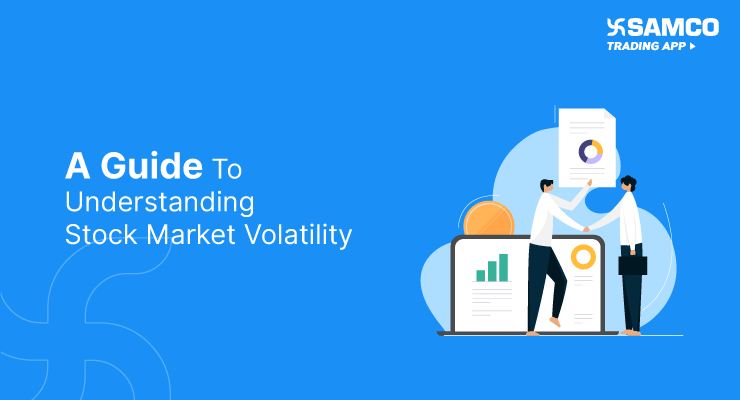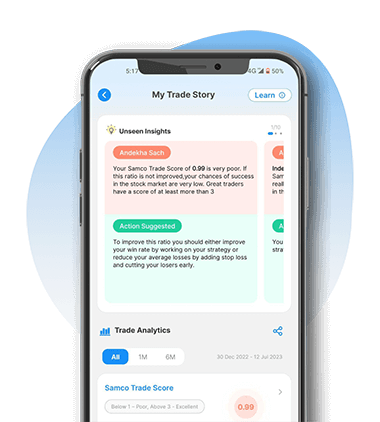In this article, we will discuss
- What is Stock Market Volatility?
- What is the Importance of Understanding Volatility?
- Types of Volatility
- How to Measure Historical Volatility
- Other Measures to Calculate Volatility
- What Causes Market Volatility?
- Conclusion
- FAQs
If you were following stock market news during COVID-19 pandemic, you must have heard people speaking of how ‘volatile’ the markets are. While it is an established fact that the stock market never stays stagnant, there are some situations that make the stock market take large leaps or dips.
If you wish to understand market volatility, its impact and its causes, you have landed on the right page. Today, we’ll discuss its meaning and why it is important to understand volatility in this blog. Stay tuned!
What is Stock Market Volatility?
Volatility in a stock is the frequency and magnitude by which price of a stock moves up or down. When we speak of market volatility, we talk about the overall value of the stock market by how much it rises or dips.
When the price swing in the stock market is big, or the frequency of such price swings is high, markets are said to be more volatile. You must understand that price in the market always fluctuates to some extent, but it is only when it starts deviating from the normal that we call them to be volatile markets.
What is the Importance of Understanding Volatility?
Every investor tends to monitor market volatility to be able to make an informed decision on their next step. It helps them determine levels of risk they should take, strategies they should follow and the right time to enter and exit the market.
While significant price swings in the stock market are a characteristic of a highly volatile market, a less volatile market is a reflection of a consistent price movement in the market. Therefore, when an investor understands volatility in the market, they also tend to better understand what impact it will have on their potential returns, along with any associated risks. This understanding allows them to develop better risk management strategies as well.
Types of Volatility
There are primarily two types of volatility in stock markets, i.e. implied volatility and historical volatility. Let’s understand them in detail.
Implied volatility
Implied volatility is the expected volatility in the stock market, especially in options trading. This volatility type is derived from the current market price of an option and is representative of how volatile the future market price of its underlying asset can be.
One thing you must remember is that implied market volatility is in no way a foolproof prediction of the future price of a stock. It is just a reflection of market sentiment and, thus, a reflection of what the investors expect the price to be in the future.
Historical Volatility
As its name suggests, historical volatility is a measurement of how much the price of a stock has deviated till now. Since it is a backward-looking metric, it does not hold as much importance as implied volatility.
Most investors take into consideration price fluctuation of the past 30, 60 or 90 days to determine it. When there is a rise in historical volatility of a stock, it is seen as an indicator of an upcoming change. Whereas when there is a dip in historical volatility, it is seen as an elimination of uncertainties.
How to Measure Historical Volatility
Since historical volatility is based on past events and data, there is a specified set of steps you can follow to calculate it.
Here is a simple example to calculate the historical volatility of a stock. Let us assume the closing price of a stock MNC Ltd. over the past 5 weeks is as follows:
Week | Price |
Week 1 | 13 |
Week 2 | 10 |
Week 3 | 12 |
Week 4 | 11 |
Week 5 | 14 |
Now, the steps to calculate the price volatility in the stock of MNC Ltd. are as follows:
Step 1: Calculate the mean
It is a simple average of all the values you are taking into consideration. To calculate the mean, you simply need to divide the sum of all values by the number of values available.
Therefore mean = (13+10+12+11+14)/5
= 60/5
= 12
Step 2: Calculate the deviation
Deviation is the difference between the mean value and all the values given in a dataset. Hence, calculation of deviation in the given set shall be:
Week | Price | Deviation |
Week 1 | 13 | 13 - 12 = 1 |
Week 2 | 10 | 10 - 12 = -2 |
Week 3 | 12 | 12 - 12 = 0 |
Week 4 | 11 | 11 - 12 = 1 |
Week 5 | 14 | 14 - 12 = 2 |
Step 3: Calculate the variance
This step might feel slightly tricky at first, but it is actually quite simple. To calculate the variance, you just need to find the square of all the deviations and then add them. Finally, you need to divide the sum by the total number of values present in the dataset, which in this case is 5.
Week | Price | Deviation | Square of deviation |
Week 1 | 13 | 13 - 12 = 1 | 1 |
Week 2 | 10 | 10 - 12 = -2 | 4 |
Week 3 | 12 | 12 - 12 = 0 | 0 |
Week 4 | 11 | 11 - 12 = 1 | 1 |
Week 5 | 14 | 14 - 12 = 2 | 4 |
As you can see, squaring this deviation has removed all the negative values. Now, the sum of these values comes down to 10. Now, if we divide it by 5, the resulting figure is 2, which is the variance.
Step 4: Find the standard deviation
The final step in calculating historical volatility is to calculate the standard deviation. This is the square root of the variance that we found in the last step. Hence:
The standard deviation of MNC Ltd. = √2 = 1.4142
By using this calculation method, investors can get an idea about how far the price of a security may deviate from its average.
Other Measures to Calculate Volatility
While we have already calculated the numerical method to calculate the volatility of a stock price, it is also measured in two more terms.
Beta
It is the relative difference between the return of a stock and the return of its relevant market index. It is another measure to find out the historical volatility of a stock. Every 1 unit of change in the beta value of a stock represents 100% of the return of its relative index.
For example, if the relative index of a stock is Nifty midcap 50, then we will measure its beta in relation to the same index. Now, if the stock shows a beta value of 1.5, then it means that for every 100% change in the value of Nifty midcap 50, the value of the stock shall change by 150%
Similarly, if the beta value of the stock is 0.75, it means for every 100% change in the Nifty midcap 50, the stock value shall change by 75%.
Volatility Index (VIX)
The original concept of the volatility index was introduced by the Chicago Board Options Exchange in 1993. The purpose of introducing it was to gauge the market anticipation in regard to price volatility and fluctuation in the stock market.
In 2003, the NSE introduced the India Volatility Index or India VIX for the Indian stock market with the same purpose. It represents the value of market volatility in percentage and is a sound indicator of the market volatility for the Indian stock market.
What Causes Market Volatility?
Volatility in the share market can arise out of several factors. These factors can primarily be divided into three broader segments, i.e. economic factors, political factors and psychological factors.
1. Economic factors
Economic factors play a key role in determining the price of almost everything in a country. Factors like GDP growth rate, unemployment rate and willingness of consumers to spend on goods and services are important aspects.
- When inflation rates increase, it affects the interest rates as well as price of goods and services in a nation. High inflation increases interest rates but causes a dip in consumer satisfaction and vice versa.
On the other hand, low inflation rates can cause uncertainty and economic stagnation, thus making the markets unpredictable and volatile.
- Inflation rate is a major factor that affects the cost of borrowing. When such costs are high, there is a slowdown in the number of loans requested. When RBI changes interest rates, it causes price fluctuation in the market and also results in high stock market volatility.
2. Political factors
When elections are around the corner, it causes uncertainty about the next ruling party, upcoming changes in the policies, and how the overall change will affect the economy. Markets are highly susceptible to fluctuations, especially before the elections and their aftermath.
The government keeps revising various policies from time to time. Changes in different policies, such as tax reforms, trade policies, etc., affect the country in different ways. Markets become especially volatile when SEBI introduces new rules or makes changes in the existing policies.
Geopolitical events like war and terrorist attacks can cause severe market crashes. They can cause severe panic among investors, thus forcing them to pull out their investments, causing an upsurge in trading activity.
3. Psychological Factors
Irrespective of what happens in the country on the economic front or the political front, investor psychology plays a key role in market volatility. Every investor has their own viewpoint on where the markets will go next, and this causes a significant impact on the price of a stock.
- When the market sentiment is positive, you will see a rise in price because investors are buying more. Whereas when these sentiments are negative, it leads to a fall in prices because of a high volume of selling of stocks
- Herd mentality is another factor where investors buy something just because everyone else is buying it. Bitcoin is a classic example of this herd mentality. Incline towards buying a stock causes price volatility and an increase in its price.
- When certain events cause investors to panic, they start selling off their holdings. Similarly, when the market becomes greedy, price rises due to a high volume of purchases.
Conclusion
Market volatility is a major player when it comes to determining your returns. There are several factors responsible for such volatility, and it is important to understand them in detail. When you understand the different causes behind this volatility, you will also be able to analyse its impact and what steps you can take next to prevent it.
Frequently Asked Questions
Q1. What is the effect of volatility on investors?
Ans. Market volatility can significantly impact the risk associated with investments of every investor in the market. It also influences their returns and their portfolio management strategies.
Q2. What are some strategies investors can use to manage market volatility?
Ans. Strategies like diversification of the portfolio, hedging your investments, dollar-cost averaging and risk management techniques, along with asset allocation, help you mitigate the impact of market volatility.
Q3. What is realised volatility?
Ans. Realised volatility is the actual market volatility that has taken place in terms of the price of a stock over a specific period.
Q4. Is it good to have volatile markets?
Ans. Some level of volatility is important in the market for investors to generate returns. For example, day traders often leverage the power of volatility to generate profits. If markets remain stagnant, they won’t be able to make much profit.
Q5. Should short-term volatility affect long-term investors?
Ans. If you are in the market for the long term, don’t let small price fluctuations affect you. You should focus more on analysing what returns you expect the stock to generate in the long run.
Disclaimer: INVESTMENT IN SECURITIES MARKET ARE SUBJECT TO MARKET RISKS, READ ALL THE RELATED DOCUMENTS CAREFULLY BEFORE INVESTING. The asset classes and securities quoted in the film are exemplary and are not recommendatory. SAMCO Securities Limited (Formerly known as Samruddhi Stock Brokers Limited): BSE: 935 | NSE: 12135 | MSEI- 31600 | SEBI Reg. No.: INZ000002535 | AMFI Reg. No. 120121 | Depository Participant: CDSL: IN-DP-CDSL-443-2008 CIN No.: U67120MH2004PLC146183 | SAMCO Commodities Limited (Formerly known as Samruddhi Tradecom India Limited) | MCX- 55190 | SEBI Reg. No.: INZ000013932 Registered Address: Samco Securities Limited, 1004 - A, 10th Floor, Naman Midtown - A Wing, Senapati Bapat Marg, Prabhadevi, Mumbai - 400 013, Maharashtra, India. For any complaints Email - grievances@samco.in Research Analysts -SEBI Reg.No.-INHO0O0005847







Leave A Comment?